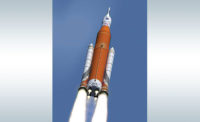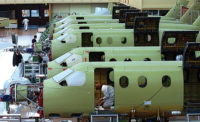Software Quickens Design of Future-Helicopter Fuselage

Spirit AeroSystems Inc. designed and developed a fuselage prototype for the V-280 helicopter at its Wichita, KS, facility, then shipped it to Bell Helicopter’s manufacturing facility in Amarillo, TX, for final assembly. Photo courtesy Collier Research Corp.

HyperSizer software is used for certification analysis of composite and metallic airframe structures, such as this airplane fuselage. Graphic courtesy Collier Research Corp.


With an eye to the future, the U.S. Army held its Joint Multi-Role (JMR) competition in June 2014 to select the next generation of high-speed-rotorcraft helicopters. Several models were showcased during the event, but only two were selected to be further developed into technology demonstration (TD) aircraft: the V-280 Valor made by Bell Helicopter, and the SB-1 Defiant, developed jointly by Sikorsky Aircraft Corp. and the Boeing Co.
The JMR-TD phase is a precursor to the Defense Department’s Future Vertical Lift (FVL) program. With an estimated budget of $100 billion, FVL is expected to replace from 2,000 to 4,000 medium-class UH-60 utility and AH-64 attack helicopters after 2030.
Spirit AeroSystems Inc. designed the tiltrotor fuselage of the V-280 Valor, which is based on the technology of the V-22 Osprey. This multi-mission, tiltrotor military aircraft has vertical takeoff and landing (VTOL), and short takeoff and landing (STOL) capabilities. The U.S. Marine Corps has fielded it since 2007; the U.S. Air Force since 2009.
Spirit unveiled a fuselage prototype for the V-280 in September 2015. Design and development was done at the company’s prototyping facility in Wichita, KS. The composite fuselage was then shipped to Bell’s manufacturing facility in Amarillo, TX, for final assembly.
Normally, it takes about two years to develop this type of fuselage. However, Spirit engineers completed the task in only 22 months with the help of HyperSizer design software from Collier Research Corp. This was the first collaboration between Spirit and Collier.
“The design-analysis cycle for a typical aircraft program requires many iterations between the designer [using CAD software] and the stress analyst,” says James Ainsworth, structural engineer for Collier. “This is a very time-consuming process.”
HyperSizer automates the structural sizing and load analysis processes. Built-in tools define the fuselage’s structural requirements for strength, stability, stiffness, deflection and rotation limitations for severe flight, landing and ground load cases.
The software also automatically generates stress reports for FAA certification, eliminating the need for manual calculations and spreadsheets. Relevant data in these reports can be reviewed and vetted to prove-out the fuselage’s structural soundness.
Bell representatives say advanced technology enables the V-280 to perform expeditionary maneuvers at high speeds with big payloads. The helicopter’s initial flight is scheduled for the second half of 2017. Company engineers insist that the aircraft should be field ready by 2025.
HyperSizer has been used by NASA and aerospace manufacturers to enhance the design of space-launch and other aircraft fabricated with composite or metallic materials since the early 1990s. The software reduces the weight of structures, on average, by 20 to 40 percent, according to Ainsworth. It is also applicable in the wind-energy, high-speed rail, automotive and shipbuilding industries.
The latest version, V7, handles large finite element models, and thousands of optimization zones and load cases. Composite laminate sequencing is now fully integrated into the sizing optimization workflow process. Also new are detailed stress-reporting and user-defined analysis plug-ins.
Besides software, Collier provides methods research and consulting services for the aerospace, wind energy and automotive industries. For more information on the company’s design software, call 757-825-0000 or visit www.hypersizer.com.
Looking for a reprint of this article?
From high-res PDFs to custom plaques, order your copy today!








